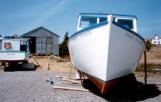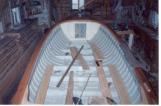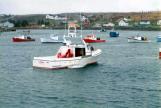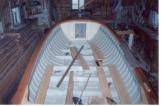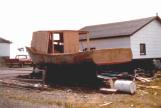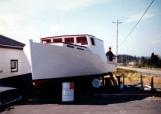3
Boats going out Main-à-Dieu harbour for the "Blessing of the fleet"Circa 2000
Main-a-Dieu, Cape Breton Island

8
Dave Forgeron and his son, preparing wooden lobster traps for fishing season1950-1960
Main-a-Dieu, Cape Breton Island

13
Wooden fishing boats have virtually disappeared, at first under a layer of fibreglass - as fishermen used this novel material to strengthen the hulls of existing wooden vessels - then altogether, as they fell out of fashion in favour of this highly durable replacement.The first fibreglass boats were in a way replicas of wooden ones, since existing wooden boats provided the mould for the fibreglass
Although several wooden boats can still be found on the water, today almost all fishing boats are made from this long-lasting, distinctly modern material. "It will outlive the man," the fishermen say.
Fishermen need to save, whether for a rainy day, or the day after a stormy one. Repairs accumulate; the wood rots; a fisherman may find himself fixing some, much, or most of his boat every few years. The top selling points of fibreglass are its strength and stamina. It can run up against a rock with minimal damage; and even if the rock punches a hole in the hull, a slathering of fresh "glass" is all that's required. Hitting the same rock with a wooden boat, the fisherman may find himself rebuilding half the vessel! That is, if he makes it back to shore.
The fibreglass boat typically arrives at least half-finished. The hull - or shell - is delivered from a manufacturer, and then the fishermen may finish the deck and house himself.
While it may not be as romantic, just as much work can go into a fibreglass boat as into a wooden boat. It begins with a foam model of the boat to be made, called a "plug," which is sprayed with a wax to prevent it from becoming inseparable from the fibreglass shell once finished. An epoxy resin is brush-rolled or spray-gunned on, giving the mould's surface a hard, durable finish.
Layers of fibreglass and resin are "laid-up" onto the surface, meaning a layer of resin is applied over every layer of fibreglass mat. A special roller is used to remove air bubbles, which otherwise significantly reduce the strength of the finished mould. Once the resin has been cured, wedges are driven between the plug and the mould in order to separate the two.
While trends in fishing may change, the fish being caught today are (more or less) the same as the fish that have been caught for millennia. Wooden boats, on the other hand, like any technology, have had to contend with competing trends. Ultimately, the wooden boat lost to the fibreglass one. The generation after the master builders, including (most of) the builders' own sons, didn't take over the craft of wooden boat-building. The fibreglass boat can't be blamed, though, considering it only really started to replace the wooden boat thirty years ago. No, the wishes of fathers and mothers that their sons get an education and make a life for themselves outside of the "family business" was often more powerful than the force of the fishing tradition.
Fibreglass is a product of our plastic age. Made from fine fibres of glass used to reinforce a polymer resin, structures made from the resulting composite have not worn out in the sixty years since the invention of material. The lightweight strength, affordability and malleability - as well as its resistance to corrosion, considering the salt environment in which a fishing boat operates - make its appeal as a building material obvious. Being lighter, of course, means the boat - and the fishermen - get thrown around more in rough water. But it's a small price to pay, they say, for the increased efficiency and decreased maintenance.
None of which is to say there aren't still wooden boats in Main-à-Dieu's harbour, even under construction in a few boat-builders' sheds.
And a hybrid of sorts has emerged, where oak planks are used to give the vessel weight - and hence minimize the rough treatment - with fibreglass put over everything for strength.
No matter what the material, a fishing boat nowadays might only stay in a fisherman's hands for 3 or 4 years, as he earns more and is able to sell that boat and buy, or build, a bigger one, over and over again, until he's able to afford his dream boat. A fisherman can work his whole life toward this goal, which can ultimately cost $200,000, with an engine that alone comes in at nearly $50,000; a vessel almost 40 feet long and more than 15 feet wide, carrying 275 traps 70 miles offshore, returning with 14,000 pounds of crab!


